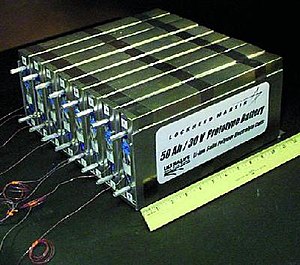
- Image via Wikipedia
The batteries in everything from computers to future electric cars might be improved by adding a compound containing boron and fluorine
The powerful lithium-based batteries used in electric vehicle systems, laptops and cell phones are prone to overheating and even blowing up, but adding less than a gram of a new substance could keep both temperatures and costs down, federal researchers say.
The molecule, developed by researchers Khalil Amine and Zonghai Chen at Argonne National Laboratory, is being tested as an additive in the electrolyte of lithium batteries to keep cell voltage from going too high.
The batteries used in hybrid and electric vehicles typically consist of 200 to 400 small cells, strung together into one powerful whole. Individual cells sometimes overcharge, emitting heat when they reach too high a voltage and pushing neighboring cells past the breaking point to set off a runaway thermal reaction.
Because electric and hybrid vehicles are constantly discharging and recharging during normal driving, overcharging problems are not confined to the garage but pose a real operational hazard.
In the lab, Amine and Chen discovered they could make a molecule based on boron and fluorine and add a tiny amount of it to each cell to control charging. When the cell exceeds the safe voltage level, Amine explained, the molecule picks up electrons and keeps the cell charge from going up.
Related articles by Zemanta
- How Long Will Tomorrow’s Automotive Lithium Batteries Last? (treehugger.com)
- A breath of fresh air for batteries (guardian.co.uk)
- DOE lab develops ‘smart charging’ for electric cars (news.cnet.com)
![Reblog this post [with Zemanta]](http://img.zemanta.com/reblog_b.png?x-id=41869da6-90f1-4623-bae5-a00a61a7f5cb)







